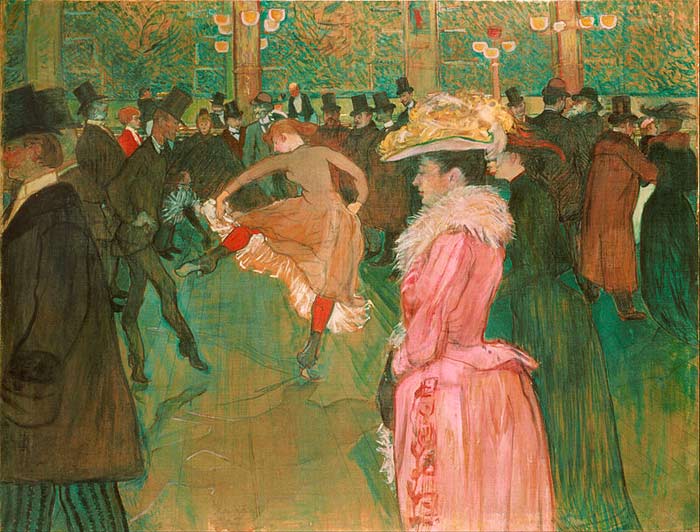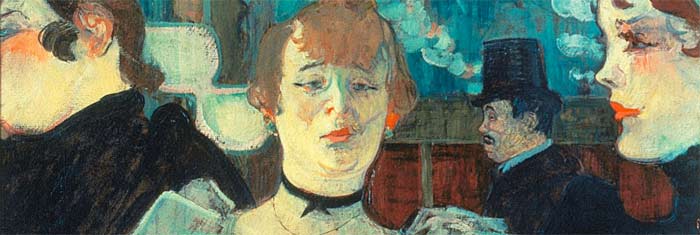What’s left in those pictures
Article by J. Danilo Garcés
It’s the end of the 19th century and you’re walking with no destination through the city of Paris, electricity is something new and the street lamps no longer illuminate the buildings with the dim light of burning gas. Just imagine how it felt to live that moment in which every corner of the world suddenly seemed to turn brighter. Think about Paris; think about where would you like to go, a museum, to a café, maybe the theater? Or just walk through the streets at night looking at the light reflected on the stone of the buildings and on the faces of every person walking by, until you find yourself lost. You end up at Montmartre one of those districts where there’re open doors everywhere and you can hear music and laughter coming from inside of each one. And there it is, the Moulin Rouge.

You have heard of this place before, stories about the people in there, the painters, the dancers and the singers, you have heard of them all. So you step inside and at the other end of the hall you see a man that seems too short for the table in which he is served another glass of cognac. Everyone around him seems to know him, you also recognize him by the stories, his name is Toulouse Lautrec and he’s drawing a girl they call La Goulue while she dances with steps full of an energy you have never seen before. Everyone laughs, it seems almost vulgar but it is not, it’s just life, kicking, dancing, sweating, and that man at the table is capturing it all in a little piece of paper.
He was always drawn to the kind of subjects not usually portrayed in fine arts, the night life, the bohemian Paris, the looked-down upon people of the time, and it was easy to understand why: he found solace in the faces of those people, compassion, and understanding. Even though he was born into nobility his decease made him and outcast among his peers and it was only in the midst of other outcast and misfits he found companion, but loneliness can only be shared and not cured among those that feel it deeply in their souls. He was a lonely man and no respectable woman would ever love him, and no woman of those he surrounded himself with was allowed to love anything at all. Maybe that was the reason he was able to see them in the intimacy of their self; he, a cripple, and them the only free women in the society of the time -and for the same reason the ones who had nothing, the ones who feared old age- they both shared the same kind of solitude.
Among them there was one, a red-head with pale skin, her name was Carmen Gaudin and she worked as a laundress and often as a model for him and other artist of the time.

She probably was more than that but so little is said of this people, so little is remember, they banish through time and only the pictures are left, and trough them we can only imagine who they were. This is what I imagine: Carmen Gaudin was not only a laundress or a model for Lautrec, she was also an infatuation, he found her not only beautiful and worth painting, he also loved to imagine loving her. In his picture of her as the laundress is easy to perceive her melancholic state as she looks out of the window, she yearns for something that life has muted so it cannot be expressed but the eco of it lingers in all of her body. Lautrec on the other hand yearns for her to turn around and look at him, he yearns for her eyes. Maybe Lautrec never really loved her, but in a way or other I like to think he did. And that’s the reason he could capture her emotions, her very being in such a truthful way, for it is only those we love without hope we can really understand.
But if that’s truth Lautrec, over all, loved life, he loved it without hope and for that he understood and was capable of capturing its most intimate moments, yearning to take part on them but only being able to watch them from afar.

He died in 1901 at 36 years old, he was an alcoholic and had contracted syphilis a couple years before; the solace he found in art and the company of those who were as lost and lonely as him could not numb the pain the way absinthe and cognac did.
The Moulin Rouge, that place from where he sketched so many of his paintings is still running today, of La Goulue the dancer he portrayed several times it’s said that she died in her sixties, forgotten by the people that once applaud and enjoyed her shows. Of Carmen, nothing is really known but only rumors that she died after the war just like so many others in the consumed Paris that came after la belle époque. But of them all there will always linger those short and intimate moments that Lautrec took and made immortal under the light of a new world that seem to be brighter.





